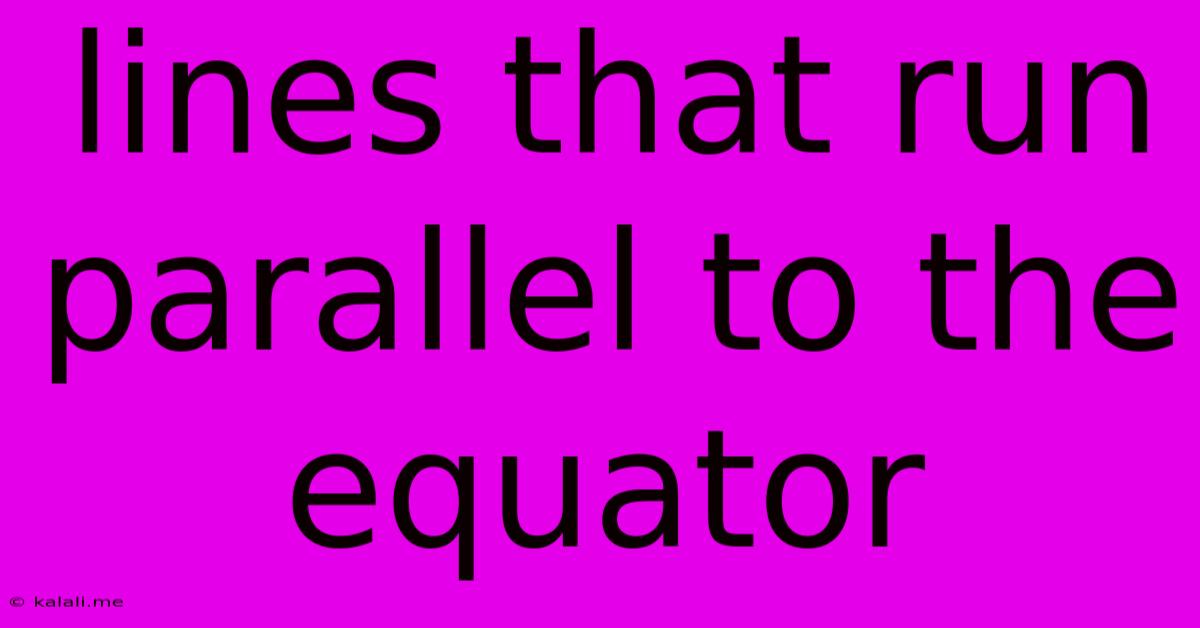Lines That Run Parallel To The Equator
Kalali
Jun 14, 2025 · 3 min read

Table of Contents
Lines That Run Parallel to the Equator: Understanding Parallels of Latitude
Have you ever wondered about those invisible lines crisscrossing the globe, neatly organized and precisely measured? These lines, known as parallels of latitude, are crucial to understanding geography and navigation. This article delves into the fascinating world of parallels, focusing on those that run parallel to the Earth's equator – the foundation of our latitude system. We'll explore their significance, how they're defined, and their role in mapping and geographical studies.
What are Parallels of Latitude?
Parallels of latitude are imaginary circles drawn around the Earth parallel to the equator. Unlike meridians of longitude, which converge at the poles, parallels remain equidistant from each other. The equator itself, located at 0° latitude, is the longest parallel and divides the Earth into the Northern and Southern Hemispheres. All other parallels are measured in degrees north or south of the equator.
The Significance of the Equator and its Parallels
The equator holds significant geographical and climatological importance. It receives the most direct sunlight throughout the year, resulting in a consistently warm climate. This intense solar radiation significantly influences weather patterns and ecosystems found along the equatorial regions, often characterized by lush rainforests. Parallels running parallel to the equator inherit some of these characteristics, although their climate varies depending on their distance from the equator. The closer a parallel is to the equator, the warmer the climate tends to be.
Defining Parallels: Degrees and Minutes
Each parallel is defined by its angular distance from the equator. The distance is measured in degrees (°), minutes ('), and seconds ("). The equator is at 0°, while the North and South Poles are located at 90° North and 90° South, respectively. Therefore, all parallels are numbered from 0° to 90° in both hemispheres. The distance between each degree of latitude is approximately 69 miles (111 kilometers). This distance, however, is not perfectly consistent due to the Earth's slightly oblate spheroid shape.
The Role of Parallels in Mapping and Navigation
Parallels, along with meridians of longitude, form the grid system used for mapping the Earth's surface. This coordinate system allows for precise location identification. Navigational systems, including GPS, heavily rely on this latitude and longitude framework to pinpoint locations accurately. Understanding parallels is essential for cartography, geographic information systems (GIS), and various fields that involve spatial data analysis.
Beyond the Basics: Applications and Further Exploration
Parallels are more than just lines on a map. They are fundamental to understanding:
- Climate Zones: The position of a parallel significantly influences its climate, impacting vegetation, animal life, and human settlement patterns.
- Time Zones: Although not directly related, parallels indirectly influence time zones because of the Earth's rotation and the varying lengths of daylight across different latitudes.
- Geographical Studies: Understanding parallels is crucial for analyzing geographical distributions, conducting environmental research, and modeling climate change impacts.
- Navigation and Surveying: The precision offered by latitude and longitude is vital for various navigation and surveying applications.
Understanding the lines that run parallel to the equator, and indeed all parallels of latitude, provides a critical framework for comprehending our planet's geography, climate, and navigational systems. They are more than just abstract lines; they represent a fundamental aspect of our world's spatial organization. Further exploration into specific parallels and their unique geographical characteristics can offer a deeper appreciation for the complexity and beauty of our planet.
Latest Posts
Latest Posts
-
Si Unit For Density Of Water
Jun 14, 2025
-
Which Of These Volcanic Eruption Types Is The Most Violent
Jun 14, 2025
-
Which Bone Is Not In The Middle Ear
Jun 14, 2025
-
What Is The Largest Cell In The Body
Jun 14, 2025
-
How Many Kg Is 350 Lbs
Jun 14, 2025
Related Post
Thank you for visiting our website which covers about Lines That Run Parallel To The Equator . We hope the information provided has been useful to you. Feel free to contact us if you have any questions or need further assistance. See you next time and don't miss to bookmark.